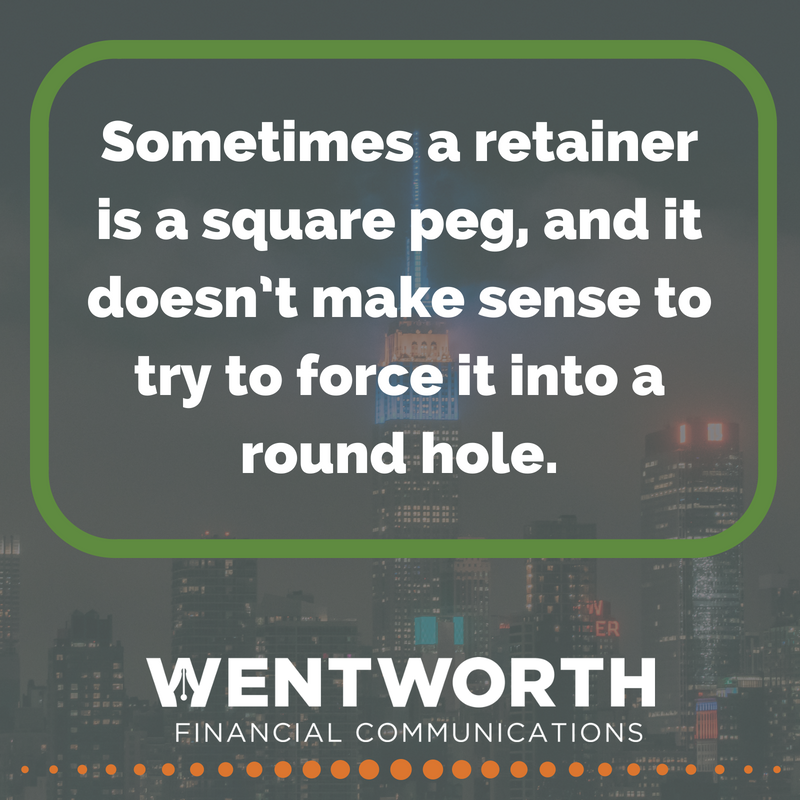In agency-world, the long-term client retainer is the golden ticket. Every agency—Wentworth Financial Communications included—covets the idea of landing that big, year-long retainer with an ideal client.
The financial benefits for the agency are obvious: a steady stream of recurring revenue, a strong pipeline of enjoyable work, and a client partnership that’s poised to evolve and (hopefully) grow over time. These are the characteristics of a client engagement that help WFC sleep well at night, grow our business, and deliver long-term value to our clients.
For their part, many clients also view long-term retainers as a valuable solution for their outsourced writing and marketing needs. Retainers allow clients to ensure the availability of their preferred vendors and maintain visibility into their monthly expenses. Often, committing to a retainer provides a discount relative to the pay-as-you-go model. Clients also appreciate having a long-term partnership that allows the agency to immerse itself in the client’s growth strategy and serve as an extension of the internal marketing team.

But despite these benefits, retainers aren’t always the right solution. Sometimes a retainer is a square peg, and it doesn’t make sense to try to force it into a round hole. We’ve found that, in many cases, project-by-project work provides greater value for clients and gives us as the writers and editors at WFC the flexibility to deliver more thoughtful, customized solutions.
To help financial services firms think through whether a retainer relationship might be a good fit for them, here are three questions firms should consider before engaging a marketing agency.
What is the volume and predictability of the work flow?
An investment firm that only needs one white paper or blog post written isn’t going to engage with an agency on a year-long retainer and look to amortize that cost over 12 months. But even in situations when the firm needs a fairly sizable amount of work done, a retainer still may not make sense. This would be the case if the workflow was “lumpy” as opposed to occurring at a fairly even cadence. It also applies if the client doesn’t know when the project will launch or how long it will last. Similarly, if the client doesn’t have much visibility into the total volume, a retainer probably doesn’t make sense.
Unless the firm knows that it has a steady flow of work that will need to be completed over a predictable timeframe, engaging in an arrangement other than a retainer might be best.
How many agencies could you trust to do the job well?
Creative work—whether it’s thought-leadership and content writing (which is what WFC specializes in), design, branding, advertising, or digital production—is a very subjective thing. While many firms may look like they’re qualified to do the work, it’s hard to find a partner who captures the nuances of your firm in terms of voice, tone, aesthetic, user experience, or other less quantifiable characteristics.
If the ongoing project is such that you trust only one or a handful of select agencies to complete the work, then a retainer might be worthwhile. One of the biggest benefits of committing to a retainer is that it reserves that agency’s time and guarantees its availability for your project.
However, if you’re confident that the work could be completed by many different agencies—or if you’re willing to run the risk that your “ideal” agency partner might not be available when your need arises—there’s less incentive to commit to a retainer.
Have you worked with the agency before?
In personal relationships, it’s important to date for a while before getting married. The same logic goes for financial services firms looking to hire a marketing agency. If you’ve never worked on a project with an agency before, then you likely don’t want to rush and commit to a long-term contract before they’ve proven their worth. Even if you’re 90% confident that they are a good fit and will do a good job, it’s better to engage in a limited, initial trial engagement first—or even two or three trial engagements—before committing to a long-term, retainer relationship.
The benefits of this apply to the agency as well. Every experienced agency knows that if a client isn’t a good fit, there are hidden costs that can eat into an agency’s profitability. Going through a few initial, limited-scope projects allows the agency to get a better idea of what these costs might be and whether the client is a good fit.
At WFC, we’re big advocates of having a “dating period” with new clients. Just as the firm hiring us wants to make sure we’re capable of delivering the quality of writing that we promise, we want to make sure that the client is a good fit for us and will be a good partner.
Finding a Model that Works for You
As you think about your next project that needs to be outsourced, we encourage you to approach potential partners with an open mind. Don’t default to the assumption that you need to enter into a retainer relationship—especially right off the bat. Just because many marketing agencies will try to sell you a retainer, doesn’t mean that your relationship needs to be structured that way.
To reiterate, we firmly believe in the date-before-you-marry philosophy. If you have five white papers to write over the course of a year, hire one agency to write the first one to see how it goes. If the agency does a great job, then you might consider signing them to a retainer for the rest of a year. If the work doesn’t meet your expectations, you can turn to another agency on your list.
For our agency and freelancer friends out there, we encourage you to adopt a similar approach. Don’t go hunting for retainers. Instead, look for clients who are a good fit for your practice and use an initial, limited engagement as an opportunity to impress them. Then, once you’ve earned their trust, you can look for opportunities to expand the relationship into something longer-term—but only if it aligns with the client’s needs in terms of volume and predictability of work.
For more insights on how financial services firms can create compelling thought-leadership content—whether on their own or by working with a ghostwriter or outsourced writing agency—subscribe to WFC’s YouTube channel.
About the Author

Frank Kalman is the chief operations officer at Wentworth Financial Communications. Frank and the team of writers and editors at WFC help professionals across the financial services industry build their brands by creating investment-grade white papers, bylined articles, newsletters, blogs, social media posts, and other forms of content marketing.
